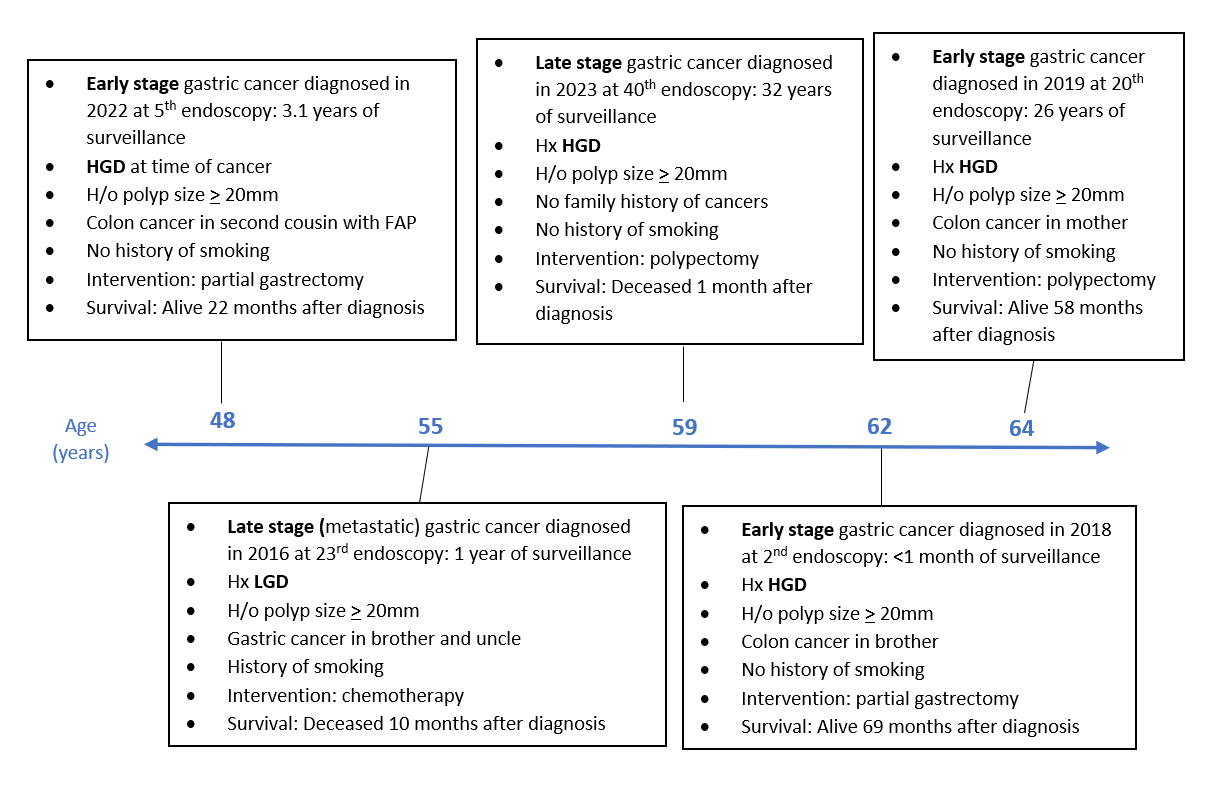Back to 2024 Abstracts
GASTRIC POLYPOSIS AND RISK OF GASTRIC CANCER IN PATIENTS WITH FAMILIAL ADENOMATOUS POLYPOSIS (FAP) SYNDROME
Rachel V. Christenson
*1, Shubham Sood
2, Robert A. Vierkant
3, Daniel Schupack
2, Lisa Boardman
2, Travis E. Grotz
41Mayo Clinic Department of Surgery, Rochester, MN; 2Department of Gastroenterology and Hepatology, Mayo Clinic, Rochester, MN; 3Department of Quantitative Health Sciences, Mayo Clinic, Rochester, MN; 4Division of Hepatobiliary and Pancreas Surgery, Department of Surgery, Mayo Clinic, Rochester, MN
Background:Familial adenomatous polyposis (FAP) patients are at increased risk for extracolonic malignancies including duodenal and thyroid for which surveillance is recommended. Nearly all patients develop fundic gland polyposis of the stomach; yet the risk factors for gastric adenomas with dysplasia and cancer remain unclear, resulting in limited understanding of their clinical course and no consensus on management. We aimed to assess gastric cancer incidence and associated risk factors in a large single-institution FAP population.
Methods:Retrospective review of patients with FAP undergoing upper endoscopy from 1989 to 2023. Analysis was done with independent sample t tests and Fisher exact tests. Cumulative incidence of cancer, by levels of FAP and HGD, were estimated using Kaplan-Meier curves. FAP and HGD were modeled as time-dependent variables.
Results:271 patients underwent 2,282 endoscopies with a median of 11.2 (IQR 5.9-18.3) years of endoscopic surveillance. During this time only 5 (1.8%) patients developed gastric adenocarcinoma. Of these, 3 (60%) had HGD on prior endoscopy, 1 (20%) had HGD at time of cancer diagnosis, and 1 (20%) had LGD on prior endoscopy. The median time from HGD to cancer diagnosis was 43.5 days. Three patients were diagnosed with early-stage cancer, and two with late-stage cancer. At a median 22-month follow-up from cancer diagnosis, all 3 patients with early-stage cancer were alive, whereas 0 patients with late-stage cancer were alive at this time. All patients with gastric cancer had a history of extensive polyposis, with a median time of 6.3 years from detection of extensive polyposis to cancer. However, once a large polyp (>20 mm) was discovered the median time to cancer was shortened to 2.1 years. FAP patients' 20-year cumulative cancer incidence is 2% with polyps, 8% with LGD, and 20% with HGD. Both HGD and polyps >20 mm were significantly associated with the development of gastric cancer (p < 0.001). During the study interval, 6 patients underwent total gastrectomy after colectomy. The median actual body weight loss at 12 months postoperative was 11.4%, with 2 patients requiring total parenteral nutrition. Of these 6 gastrectomies, 4 were prophylactic without cancer and 2 were therapeutic for cancer.
Conclusion:Our institution observed an increase in the incidence of gastric cancer in FAP patients over 34 years, possibly reflecting changes in the phenotypic presentation of FAP in the US. Although the overall risk of gastric cancer in FAP patients is low, outcomes are poor once cancer is diagnosed. Patients can be risk stratified using HGD and large polyps on endoscopic surveillance. This suggests a role for long-term endoscopic surveillance in FAP patients with gastric polyposis. Prophylactic total gastrectomy should be considered only for patients with HGD and large polyps on endoscopy.

Back to 2024 Abstracts
